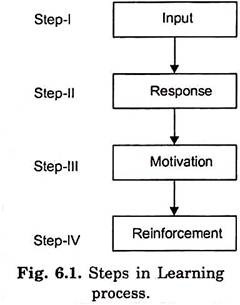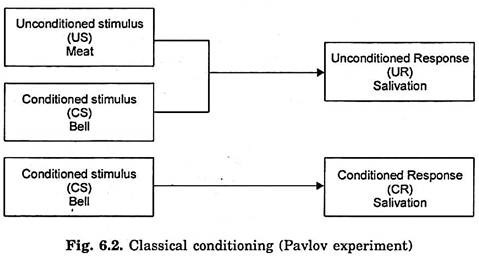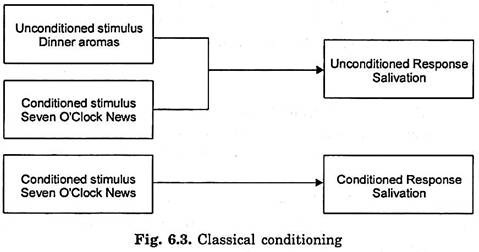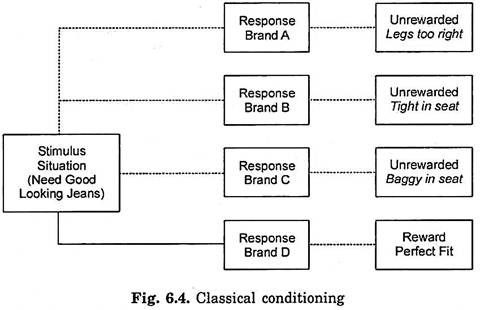Here is a term paper on ‘Learning’ for class 9, 10, 11 and 12. Find paragraphs, long and short term papers on ‘Learning’ especially written for school and management students.
Term Paper on Learning
Term Paper Contents:
- Term Paper on the Meaning of Learning
- Term Paper on the Nature, Features and Characteristics of Learning
- Term Paper on the Learning Procedure
- Term Paper on the Theories of Learning
- Term Paper on the Principles of Learning
Term Paper # 1. Meaning of Learning:
Learning is a continuous process. It occurs all the time. Learning is any relatively permanent change in behaviour that occurs as a result of experience. We can say that the changes in the behaviour indicate that learning has taken place and that learning is a change in behaviour.
ADVERTISEMENTS:
Learning is a change in behaviour through education and training, practice and experience. It is accompanied by acquisition of knowledge, skills and expertise which are relatively permanent. Temporary changes may be only reflexive and fail to represent any learning. If reinforcement does not accompany the practice or experiences, the temporary change in behaviour will eventually disappear. It is reinforcement which makes learning or change in behaviour enduring by strengthening and intensifying certain aspects of an individual’s behaviour.
Learning may be described as the process of acquiring the ability to respond adequately to a situation which may or may not have been previously encountered, as the favourable modification of response tendencies consequent upon previous experience, particularly the building of a new series of complex co-ordinated motor response the fixation of times in memory so that they can be recalled or organised; the process of acquiring insight into situation. Thus, learning can be defined as a relatively permanent change as a result of prior experiences.
Term Paper # 2. Nature, Features and Characteristics of Learning:
The concept of learning highlights the following characteristics:
1. Learning involves change. This may be good or bad from an organisational point of view. People can learn unfavourable behaviours as well as favourable behaviours.
ADVERTISEMENTS:
2. The change must be relatively permanent. Temporary changes may be only reflexive and fail to represent any learning.
3. Learning takes place when there is a charge in actions. A change in an individual’s thought processes or attitudes, if accompanied by no change in behaviour, would not be learning.
4. Some form of experience is necessary for learning. This may be required directly through observation or practice or it may result from indirect experiences such as that acquired through reading.
5. The practice or experience must be reinforced in order for learning to occur. If reinforcement does not accompany the practice or experience, the temporary learned behaviour will disappear and hence no learning would be there.
ADVERTISEMENTS:
6. Learning occurs throughout one’s life and hence it is a continuous process.
Term Paper # 3. Learning Procedure:
There are four steps for the learning to take place (Fig. 6.1):
Step 1:
Input:
There should be a stimulus which is clearer to the learner. In work settings, unless the employee understands the messages communicated by the management, he is unlikely to be affected in the appropriate direction as intended by the communication.
Step 2:
Response:
It means the act which the learner has to perform. He should be allowed and encouraged to practice the process.
Step 3:
ADVERTISEMENTS:
Motivation:
There must be a motivation or drive before there can be any learning. Motivation involves interest and the attitude to learn. A person is likely to learn if he possesses adequate capacity to learn and understand what is being taught process.
Step 4:
Reinforcement:
ADVERTISEMENTS:
Reward or incentive refers to what satisfies a motive. If the person is not rewarded or does not perceive the likelihood of the reward in near future, he stops learning and even tends to unlearn the skills which he already possesses.
These steps in learning have a direct bearing on training in oganisational settings.
Training can be effective if these steps are adhered to. Management often takes into account only stimulus and response but ignores the actual motivation of the trainee and requirement for giving a feeling of adequate forthcoming reward.
Term Paper # 4. Theories of Learning:
ADVERTISEMENTS:
Four theories have been offered to explain the process by which we acquire pattern of behaviour.
These theories are:
(A) Classical Conditioning:
It is a type of conditioning where an individual responds to some stimulus that would not invariably produce such a response.
Classical conditioning grew out of experiments to teach dogs to salivate in response to ringing of the bell, conducted by Russian Psychologist, Ivan Pavlov.
A simple surgical procedure allowed Pavlov to measure accurately the amount of saliva secreted by a dog. When Pavlov presented the dog with a piece of meat, the dog exhibited a noticeable increase in salivation. When Pavlov withheld the presentation of meat and nearly rang a bell, the dog has no salivation.
ADVERTISEMENTS:
Then Pavlov proceeded to link the meat and the ringing of the bell. After repeatedly hearing the bell before getting the food, the dog began to salivate nearly at the sound of the bell even if no food was offered. In effect, the dog learned to respond, that is to salivate to the bell.
The meat was an unconditioned stimulus. It invariably caused to dog the react in a specific way. The reaction that took place whenever the unconditioned stimulus occurred was called as unconditioned response. The bell was the artificial stimulus or conditioned stimulus.
While it was originally neutral, when the bell was paired with the meat (an unconditioned stimulus), it eventually produced a response when presented along. It is the conditioned response. This describes the behaviour of the dog salivating in reaction to the bell alone.
Using these concepts we can summarize the classical conditioning. Learning a conditioned response involve building up an association between a conditioned stimulus and an unconditioned stimulus. Using the paired stimuli, one compelling and other one neutral, the neutral one becomes a conditioned stimulus and hence takes on the properties of the unconditioned stimulus.
Classical conditioning is passive. Something happens and we behave in a specific way. It is elicited in response to a specific, identifiable event. As such it cans behaviours. But most behaviour Conditioned stimulus particularly the complex behaviour of individuals in organisation is emitted rather than elicited. It is voluntary rather than reflexive. For example, employees choose to arrive at work on time, ask their superior for help with problems. The learning of these behaviours is better understood by looking at operant conditioning.
(B) Operant Conditioning:
Operant conditioning is defined as behaviour that produces effects. Operant conditioning given by Skinner suggests that individuals emit responses that are rewarded and will not emit responses that are either not rewarded or are punished.
Operant conditioning is a voluntary behaviour and it is determined, maintained and controlled by its consequences. In contrast, respondent behaviour is an involuntary response to an environmental stimulus.
Operant conditioning acts on environment to produce consequences. It is basically assumed that man’s behaviour is determined by environment and alteration in their environment. Operant conditioning presupposes that human beings explore their environment and act upon it. In classical conditioning the sequence of event is independent of subject’s behaviour.
In operant conditioning reinforcement is given only when the correct response is made. According to Skinner, the consequences determine the likelihood that the given operant will be performed in the future. To change behaviour, the consequences of that behaviour must be changed.
Operant conditioning is a powerful tool for managing people in organisations. Most behaviour in organisations are learned, controlled and altered by the consequences, i.e., operant behaviours. Management can use the operant conditioning process successfully to control and influence the behaviour of the employees by manipulating its reward system. If one expects to influence behaviour, he must also be able to manipulate the consequences.
ADVERTISEMENTS:
Four types of Reinforcement Strategies can be employed by managers to influence the behaviour of the employees:
(i) Positive Reinforcement:
It strengthens and increases behaviour by the presentation of the desirable consequence (reward). Positive reinforcer is a reward that follows behaviour and is capable of increasing the frequency of the behaviour.
Effective reinforcer must meet the two conditions:
(а) The reward should be contingent upon the rate of performance.
ADVERTISEMENTS:
(b) The reward should be matched with the need or the desire of the performer.
There are two types of positive reinforcer:
(a) Primary Reinforcers:
Primary reinforcers such as food, water and sex are of biological importance in that they are innately satisfying and have effects which are independent of past experiences. Primary enforcers must be learned.
(b) Secondary Reinforcers:
Secondary reinforcers such as job advancement, recognition, praise and esteem, result from previous association with a primary reinforcer.
In order to apply reinforcement procedures successfully, management must select reinforcers that are sufficiently powerful and durable.
(ii) Negative Reinforcement:
The threat to punish rather than to give reward is called as negative reinforcement. Negative reinforcers also serve to strengthen desired behaviour responses leading to their removal or termination. Negative reinforcement is employed to increase the frequency of a response by removing a noxious consequence. People learn a negatively reinforced behaviour through an avoidance learning process. Skinner approach is primarily based on the principles of the positive reinforcement only.
(iii) Extinction:
It is an effective method of controlling undesirable behaviour. It refers to non-reinforcement. It is based on the principle that if the response is not reinforced, it will eventually disappear. For example, a teacher ignores noisy students; the student may drop the attention getting behaviour. Extinction is less painful than punishment because it does not involve the direct application of an aversive consequence.
Students who perform well are praised quite often by the teachers. If they begin to slack off and turn out poor performance, the teacher may try to modify their behaviour by withholding praise. Extinction is a behavioural strategy that does not promote desirable behaviours but can reduce undesirable behaviours. If the students eventually show the good work, the teacher may again praise them (positive reinforcement) but if the poor performance is again resulting in, extinction will be re-employed.
(iv) Punishment:
It is a control device employed in the organisations to discourage and reduce annoying behaviours to others.
It can take either of the two forms:
(a) There can be withdrawal or termination of a desirable or rewarding consequence.
(b) There can be an unpleasant consequence after behaviour is performed.
Punishment reduces the response frequency as it weakens behaviour. The use of abrasive control is the most controversial method of modifying behaviour because it produces undesirable by-products.
Instrumental learning theorists believe that learning occurs through a trial and error process, with habits formed as a result of repeated rewards received for certain responses or behaviours. This model of learning applies to many situations in which consumers learn about products, services and retailers.
Critics of instrumental learning theory points out that a considerable amount of learning takes place in the absence of direct reinforcement, either positive or negative. We do not have to be arrested to know that we would obey the law. Individuals learn a great deal through a process psychologist’s call modeling or observational learning (vicarious learning). They observe the behaviour of others, remember it and imitate it.
Instrumental theorists argue that children learn in this way because they can envision a reward and therefore imitate the behaviour that leads to it. But critics maintain that instrumentation confuses learning and performance (behaviour). Both children and adults learn a great deal that they do not act upon. Moreover, they may learn merely for the sake of learning, not for the sake of rewards.
The belief that learning is a function of thinking, of mental processes, is known as cognitive theory.
(C) Cognitive Theory:
The theory was given by Tolman. He held that learning involves a relationship between cognitive environmental cues and expectations. He evolved and tested this theory through controlled experiments using rats in the laboratory. He showed that rats learned to run through a complicated maze towards a goal (food). It was observed that rats developed expectations at every choice point in the maze.
Thus, they learned to expect that certain cognitive cues related to the choice point could ultimately lead to food. In situations where rats got the food, the relationship between the cues and expectancy was strengthened and learning look place. Tolman approach is also called as stimulus-stimulus approach.
These experiments embarrassed the behaviouristic learning theorists. Reinforcement failed to predict rat’s behaviour and it was no longer a prerequisite to learning. One stimulus led to another stimulus rather than classical S-R or operant R-S interpretation. Indeed the rats behaviour was purposive. In other words, they learned a cognitive map to determine how to reach food.
Tolman made significant contributions to learning theory by forcing the behaviouristic theorists to evolve highly complex explanation of behaviour and indicating the need to include cognitions in a mediating role between the environmental stimulus and the behaviour. These theories exerted a strong effect on early human relations movement.
(D) Social Learning Theory:
Individuals can also learn by observing what happens to other people and just by being told about something as well as by direct experiences. For example, what we learn comes from watching models parents, teachers, peers, superiors and so forth.
While social learning theory is an extension of operant conditioning that is it assumes that behaviour is a function of consequences. It also acknowledges the existence of observational learning and the importance of perception in learning. People respond to how they perceive and define consequences, not to the objective consequences themselves.
The influence of models is central to the social learning viewpoint. Four processes have been found to determine the influence that a model will have, on an individual.
These are:
(i) Attentional Processes:
People only learn from a model when they recognize and pay attention to its critical features. They tend to be most influenced by models that are attractive, repeatedly available and we think are important or we see as similar to us.
(ii) Retention Processes:
A model’s influence will depend on how well the individual remembers the model’s action, even after the model is no longer readily available.
(iii) Motor Reproduction Processes:
After a person has seen a new behaviour by observing the model, the watching must be converted to doing. This process then demonstrates that the individual can perform the modelled activities.
(iv) Reinforcement Processes:
Individuals will be motivated to exhibit the modelled behaviour, if positive incentives or records are provided. Behaviours that are reinforced will be given more attention, learned better and performed more often.
Term Paper # 5. Principles of Learning:
Learning principles are the guidelines that help a manager to gain maximum efficiency in a learning situation. These guidelines are to be applied in content of the task and the level of the person.
These principles are:
1. Knowledge of Results:
It is stated that the knowledge regarding one’s own performance is a necessary condition for learning. Feedback about the performance enables the learner to know where he stands and the corrective action can be initiated if any deviation from the expected goal has taken place.
2. Motivation:
Motivation is related in several ways to learning. The extent to which valued rewards follow high performance, for example, will affect an employee’s willingness to work hard in the future, and the cause and effect linkage needs to be clear. That is, employees should recognise that certain behaviours (such as hard work) cause certain outcomes (desired rewards).
Similarly, if rewards do not follow performance, the employee may be less inclined to work hard in the future. A lot of research, the learning process in organisations has been done recently. These studies have led to the development of a motivational perspective called organisational behaviour modification.
3. Reinforcement:
Reinforcement is very important for learning because behavioural response is conditioned by reinforcement. We may define reinforcement as anything that both increases the strength of response and tends to induce repetitions of the behaviour that preceded the reinforcement.
Four types of reinforcement strategies can be employed by managers to influence the behaviour of employee’s viz.:
(i) Positive reinforcement,
(ii) Negative reinforcement,
(iii) Extinction, and
(iv) Punishment.
4. Learning Curve:
The principle of learning involves the time factor and the repeated efforts in order to gradually increase the strength of the response. This is especially true when the behaviours to be learned are comparatively complex such as skills that are learned and improved by practice. For example, a person who wants to learn typing would execute awkward strokes in the beginning, but under guided supervision, time and conscious repeated efforts, the skill is improved and as the person gains confidence, the rate of typing speed increases until a maximum rate possible for him is reached.
The limiting factor may depend upon motivation, coordination or other physical constraints. This means that as the practice time increases, the degree of skill also increases. However, the rate of increase in the degree of skill is higher in the beginning but decreases with time until it reaches zero and the person has obtained the maximum skill.
5. Meaningfulness of the Subject:
A definite relationship has been established between learning and meaningfulness of the subject learnt. More meaningful the materials, better does learning proceed. Acquisition of nonsense syllabus proceeds more slowly than that of prose or poetry. On a broader scale, a programme of learning where each task makes for meaningfulness, trainers do have certain techniques that are meaningless for trainees. Organising meaningful units, creating association with already familiar terms, and providing a conceptual basis or logical reason for the material are some of the practical possibilities.
6. Schedules of Learning:
Probably one of the most well established and well documented learning principle is that distributed or spaced practice is superior to continuous or massed practice. This seems to be true for both simple laboratory tasks and for highly complex tasks.
Actually, schedules of learning can be manipulated in three different ways as:
i. Duration of practice sessions.
ii. Duration of rest sessions, and
iii. Positioning of rest sessions.



